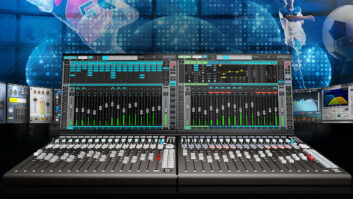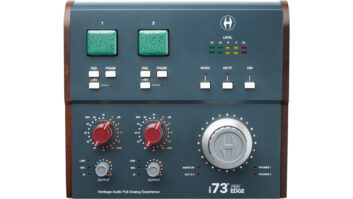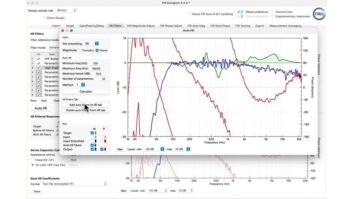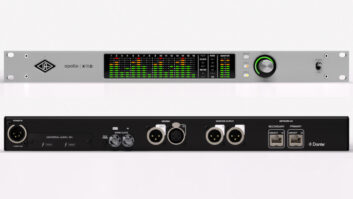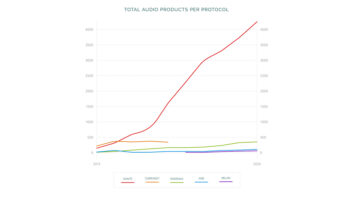By Frank Wells.

Each year, Pro Sound News queries audio design engineers about their semiconductor usage and the impact on the products you employ. This elongated web version of our report includes all of the comments from our respondents.
In 2011, previously reported semiconductor trends in audio design continue to dominate the discussion. Our respondents report using a few new components this year, though David Clementson, managing director for design consulting firm High Gain Design, says the new parts his company is employing are “still confidential to their manufacturers.” Peter Montessi, president of analog specialists A Designs Audio and Pete’s Place Audio, is working with proven components that are only new to his designs, specifically the THAT Corp 1200-series InGenius balanced line receiver IC, “which fit our needs perfectly for one of our products.” Until recently, Montessi says he has not employed such building block components, “but within the last few years or so with some of our newer designs, we have incorporated more… I remain hopeful that we will continue along these lines to replace outdated parts.” He reports currently using these building block components “mainly for VU metering. This allows us to build a smaller PCB with surface mount as a daughter board saving costs and space.” Empirical Labs President and Chief Engineer Dave Derr says he also turns to THAT for VCA’s and RMS Detectors to supplement traditional components, as the chips “work great and require little trimming.”
Clementson says that he generally employs monolithic function parts “only when there is an advantage to doing so. For instance, semiconductor manufacturers can laser-trim resistors cost effectively, where board–level manufacturers do not. So when you need good matching like on an audio receiver, an integrated solution can often give better performance than a board level solution.”
The feature set of the finished product dictates the components used, says Clementson: “For traditional features, I use the same old parts. But there are new features that need new parts…the new features require non-audio parts, but they are still for audio devices. For example, many newer DSPs require sequenced power supply rails, so voltage regulators with built-in sequencers are needed.” Montessi says his legacy products continue to rely on the original specified parts, with a caveat—“For the products we have been manufacturing for 12 years, we continue to use the same components, but we find we are having a harder time sourcing those parts at a fair price point these days.”
Derr says Empirical Labs is largely using traditional components, but they are “swapping out some components since going RoHS, as RoHS has increased our failure rates, many folds.” The European RoHS (Restriction of Hazardous Substances) regulations, which include a ban on lead solder, are one factor that has changed the semiconductor market drastically in recent years. Clementson says also that traditional parts “requiring large geometry, high-voltage (>36 volt) semiconductor processes” are disappearing “because the industry always pushes faster, denser, low voltage processes. For the high voltage parts, I have gravitated to using Texas Instruments parts when I have a choice partly because I’ve been told by their executive managers that they are committed to the high voltage processes required for the Industrial Instrumentation market. To a large extent, Pro Audio is piggybacking off of that much larger market.”
Montessi calls the availability of legacy components “a sore spot with me.” He explains that “just about every part we use is becoming more difficult to source and more expensive as well. I understand what our vendors are going through in these strange economic times and I’m sure everyone is feeling it as well. No one wants to stock and have product sitting on the shelf collecting dust and not bringing in working capital. So vendors are now building to order. This creates a mess for us as manufacturers because lead times are two to three times longer and the prices, in most cases, are soaring through the roof, which in turn means we spend more time sourcing and generally more money all the way around. There are still deals to be had, but they seem few and far between. I do my best to keep prices down, but with all things considered, raising retails at this time is a slow death for any company.” For Empirical Labs, “Some germanium stuff is getting hard to find,” says Derr, who adds that “Clarostat has raised the price of their potentiometers every single order and it’s getting tiresome.” The range of available potentiometers has been narrowed for decades in smaller quantities. Derr says, “I think they are sending the message they don’t want to deal with small companies, even though our last order for a single value pot, was over $130,000!” With “bad news” from Clarostat, Derr says emphatically, “Bourns is much better.”

Clementson says there’s little room for adaptation in approach “if the product requires ‘pro’ level analog outputs like +24 dBu. Short of using transformers, you need high voltage process parts to generate those outputs. It really comes down to what kind of PSU technology is being used and how the power supply rails are apportioned across the design. With linear regulators, there is no power advantage to using lower voltage parts everywhere except the output stages. The power consumption is the same. If switching regulators are used, significant power savings can be had by using lower rail voltages on selected circuits. This can really help when trying to squeeze lots of channels in a 1U box.”
“Buying larger quantities for stock, and price breaks,” is how Derr copes with component scarcity. “Large orders of inventory has been our best investment,” he explains, “often saving us 30% because of quantity breaks. You have to have great cash flow though, to do this safely.” Montessi says there’s no real adapting, “The best you can do is ‘Eat It!’ until the storm blows over. I have not increased our prices for two years. I saw this coming, so what I did was cut the fat as much as we can. My company works differently than most out there today. But I’m seeing more companies adopting our way of manufacturing.” Montessi is reticent to share details: “If I tell you how we work, then I have to kill you ;>)”
Surface mount components are cropping up more in new design. “We are moving into SMT components in the near future,” says Derr, while Clementson is embracing “surface mount always except for film caps which can melt in SMT form. The cost of thru-hole installation labor is prohibitive. You just need to know which SMT components to use and which to avoid.” While surface mount technology is conducive to automated manufacturing, Montessi says that his companies decline to use surface mount components in the audio path, reserving it for out-of-the-flow circuits like metering. “Surface mount is the wave of the future and I understand that,” he explains, “but the one drawback that it has is ‘repair.’ If I have a resistor that has gone south or a cap, then it is much easier for a Service Department to repair than a SM part. Not everyone has made the change, so education plays a major roll in servicing for both thru hole and surface mount.”
Clementson says that “of course” there are legacy components still routinely employed. “Everyone uses the 5532 for cost and performance. Besides, the CAD symbol is already done…” Derr concurs that there are “lots of legacy chips” he uses, but declines to share part names for intellectual property protection reasons.
While qualifying that A/D and D/A conversion part selection is product dependent, Clementson says that “modern Pro Audio market requirements are all about converter group delay, so that narrows down the parts selection to the usual suspects. It also helps to know where the bugs are in these converter chips (they all have bugs) and how to handle them at product level.” Derr says “performance and ease of use” are key in converter parts selection, “however, it seems like everyone uses the same parts at the same time.” Clementson is using new components, though hedges on sharing details: “I had a product requirement for a much lower price point than previous designs. The PN is customer confidential, however. Another design required a novel converter topology, also confidential.”
Clementson is the only of our surveyed designers using sample rate conversion component. “After negotiation,” he reveals, “the Cirrus SRC parts ended up cheaper than the others, so they got the design in. I think SRC has become a commodity, though, since I’ve never heard of a customer commenting on the sound of the SRC regardless of the brand of SRC chip.” He also declined to name names in interface parts for formats such as USB and FireWire, but does minimally admit to using “home-grown FPGA and standard PHY chipsets.” Clementson declares that the software and firmware drivers are the issue. “The hardware is mostly trivial,” he states. “Don’t even think about implementing a new interface unless you are absolutely certain you have the driver aspect covered.” He also calls the current crop of dedicated interface devices “generally too expensive except for one-off designs.” Where dedicated devices are available, Clementson says that, “Again, unless the driver is available, the device is unusable. As the interfaces get more complex (like AVB), the software component is even more important. Even though I am considered a hardware designer, I now spend most of my time writing code.”
Power supply voltage regulators, specifically “super low noise regulators,” is one area where Derr finds the available components lacking. “Aren’t we getting tired of lackluster performance from the 78XX and 79XX regulator parts?” he asks. “Come on IC manufacturers! The market for a low noise, inexpensive, pin compatible regulator for these old 78xx and 79xx parts is friggin’ huge! Billions of dollars worth of business over time. Just make them quieter and pin compatible.”
The move to computer buss powered devices, or low voltage portable devices, forces different approaches to circuit design than with traditional rack mounted gear. Clementson says that this “definitely” presents challenges though “only on outputs. Input attenuators are required regardless. You naturally use the lowest rail voltage needed for the task at hand, and DC-DC converters as required. Having a high efficiency DC-DC converter design is a must. But the issue is power, not voltage. For example, a +48V phantom mic can draw up to about a watt. How then does one put eight mic inputs on a USB device that is limited to 2.5 watts? The channel count will be severely restricted for all but the simplest, low performance designs.” Derr says he is challenged “a little,” adding that compromises are somewhat mitigated because “lots of stuff is working differentially so you can cancel noise.”
For his DSP designs, Clementson says the components chosen are dependent “on the algorithms and development environment. The first question is the number system – float vs. fixed vs. word size. Then is the source in C or assembly? Once those questions are answered, the choices are narrowed.” There are “absolutely” advantages with different families of processors, he continues. “For example, highly pipelined architectures can achieve very high performance, but only on certain algorithms. Many of them are designed for video processing, which is a very different beast from audio processing. You need an expert who knows both the algorithm and the DSP architectures to make the right choice.” Derr explains that DSP component development is not driven by commercial markets as with generic digital computing and processing parts. “It’s possible general purpose processors may take over much of the DSP market,” he says, “since they are always using higher clocks, more versatile, and are going to floating point math.”
As for DSP design toolsets, Clementson says you “have to use what is available. Most IDEs are pretty similar these days, but the debugging infrastructure vary, especially for real time debugging.” Clementson has also embraced FPGA processing—digital building blocks that are programmed on a device specific level for tailor-made processing. He explains, “The cost advantage is tremendous if the algorithm is simple, the channel count is high, and the need for programmability is low.”
Native processing, audio DSP done inside a computer’s CPU, is “absolutely” becoming more advanced and attractive to Derr, who cites “a gradual stream of improvements.” Clementson qualifies his affection for native processing: “Getting the OS to do what you want it to do when it needs to be done is always a problem unless you write the kernel yourself. The trend in modern programming is to relegate the application to ‘user mode’ and to keep the kernel private to the OS. Good luck doing much realtime processing in that environment.” There’s no favoritism amongst CPU brands among our respondents, with Clementson surmising, “Again, you use what you have to, meaning the platform dictates the processor.”
For system control, the human interface factor, Derr says he typically relies on hardware separate from signal path elements, while Clementson says his control approach “depends on cost, what the development language is, and if the UI is physically separated from the signal processing. Certainly using a separate UI processor eases development, but as the customer’s UI expectation grows, so does the control processor cost and development effort.”
Asked what advice they have to share for end-users on a quest for quality, Clementson says, “The truth is that the audio quality of even the cheapest product is generally really, really good, so shop for features you need first. If you are told there is a sound quality difference between two products, force yourself through a double-blind listening test to find out if there really is.” Derr suggests that end-users do their research and “see what others think of the item. Newer is not always better. Put off upgrading software on your computer for as long as possible!” Montessi calls gear selection “an age old problem for the consumer and I fully understand how hard this is. The only advice I can give, is to try and demo any and all units that you are considering on purchasing. I know this is very difficult to do because dealers will not send a unit to demo in some cases, but I am seeing that dealers are changing in that respect and you should contact your dealer and ask. But when you do this, you should demo the units in your studio with your setup and your room to see what works best for you.
“The next option would be to visit the online Forums. By doing this, you also run into a rats nest. Search and read up as much as possible and do your best to seek out someone that is a trusted poster. If you don’t do this, then you are taking someone’s opinion that (more than likely) is just a scam artist that has no clue and has never even turned a Pro piece of gear on in a studio or anywhere else for that matter. All he is doing is repeating hearsay and has no life, but wants to have everyone think he/she is the top of the food chain and knows everything.
“Other than that, it’s like buying a new car…would you just go to a car lot and have the salesman/woman sell you car that he gets paid a hefty commission for, rather than a car that is right for your needs and within your budget.”
As for the general future of the component market, Montessi says, “At this point, the field is wide open. If something comes along that fits our needs, then we will look into it.” Clementson urges “other designers to learn a little about semiconductor processing technology and what economic forces drive that marketplace. Semiconductor physics rules our world now, and we need to learn those rules.”
